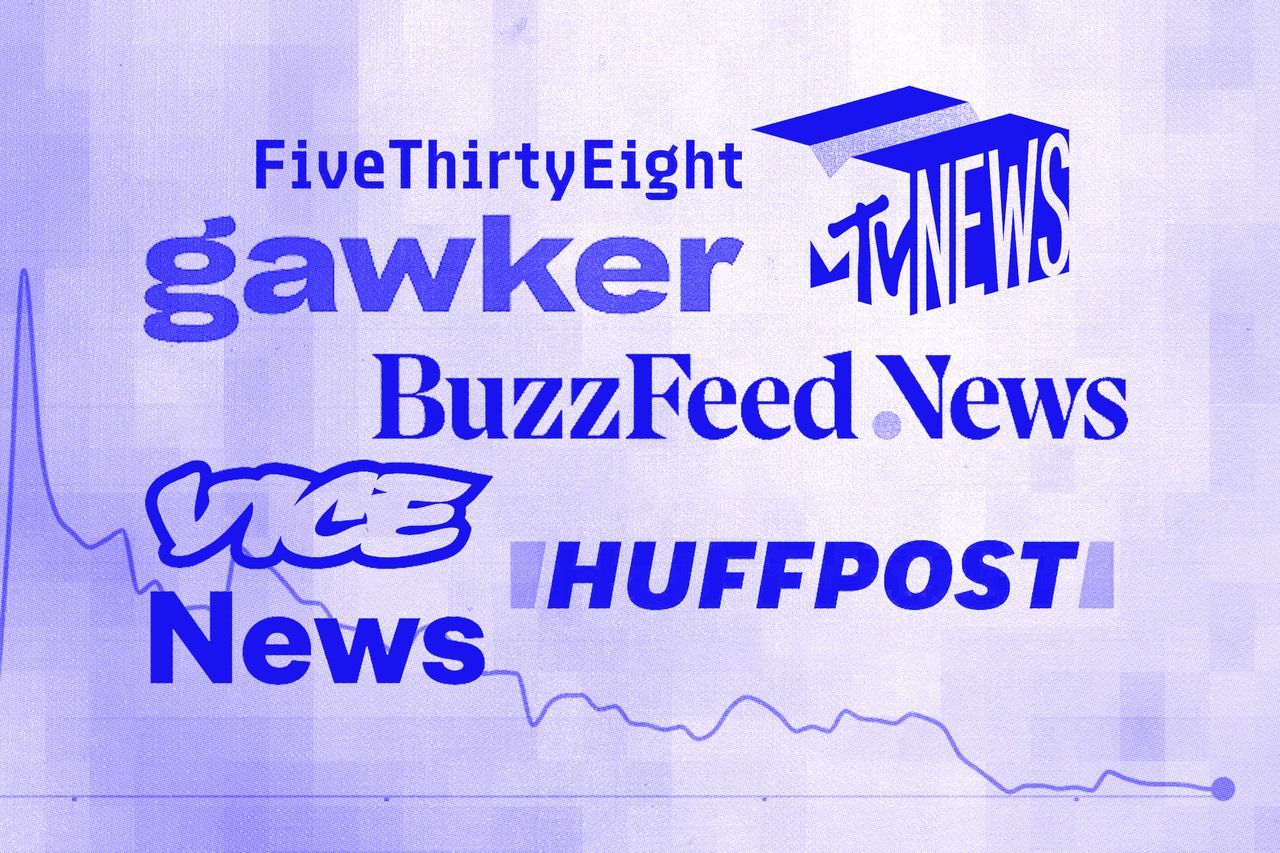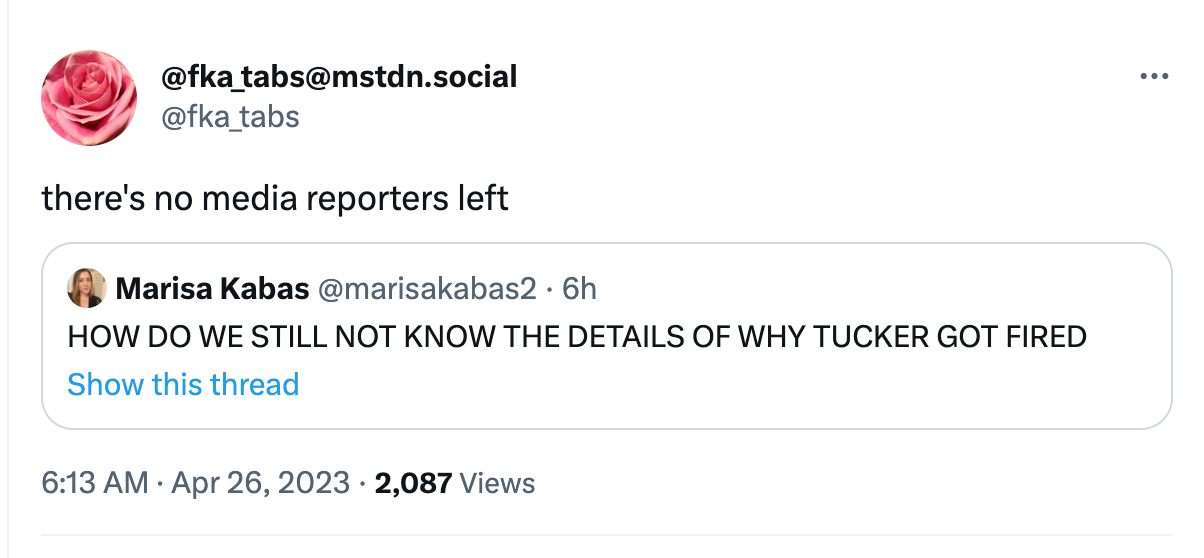The digital media experiment is over. What comes next?
They were the beloved upstarts of the millennial era. Now publications like BuzzFeed and Vice are the ones being disrupted. Where did the dream of the 2010s go wrong?

Image: Emily Thiang
And with a single quote tweet, Twitter user @fka_tabs did what I had been trying in vain to do for the better part of a week: weave the two biggest media stories of the year into a single cogent thought.

To be fair (to myself), it has been quite the year for media stories. The biggest of the two was the Fox News defamation case, which you may recall ended in a surprise eleventh-hour settlement, and which resulted not just in the largest payout ever made by an American media company, but also in the very public firing of Tucker Carlson, Fox’s racist, testicle-tanning conspiracy theorist.
The Fox-Carlson story has been interesting enough to follow on its own, full of tantalising details about how the world’s most powerful nonagenarian manages America’s most influential newsroom (and his love life). Yet it is, in the scheme of things, insignificant. As big as the cable news network is in the US, and as interesting as it’s been to rifle through their dirty laundry, the plight of the organisation and its one-time news anchor has relatively little to say about the current moment. Fox News is, after all, a cable service; a decidedly (if not technically) ’90s medium used by more 68-year-olds than, to pick a non-boomer metric more or less at random, Twitter users.
By contrast, the other biggest media story of 2023 says far too much about the current moment. This one began in January, when Vox Media announced layoffs at New York Magazine, Eater and Thrillist, but new chapters have been added almost daily. The Washington Post, News Corp, NPR, CNET, Huffington Post, Bustle, Business Insider, National Geographic, FiveThirtyEight—each has had its editorial rooms slashed in a spate of mass restructurings that are collectively starting to look more like a neoliberal pandemic than a typical industry downturn.
But to focus on the layoffs would be to bury the lede. Gawker, Catapult, Pop Up Magazine, Paper, BuzzFeed News, Vice News and MTV News—all have shuttered their doors for good, heralding an end to what now looks like a golden age of new media, but which was itself already a withered husk of the ‘true’ golden age, which can be loosely dated as occurring at any point before the invention of the internet.
The result: thousands of writers and journalists are now looking for work in an industry that’s never been so poorly positioned to employ them. And while the impact on readers won’t be anywhere near as existential, it’s safe to assume that the internet (and, to a lesser extent, newsstands) will be a lot less vibrant. Many of these publications added colour to what can often be a monochromatic industry, and all of them broke stories that otherwise wouldn’t have been broken (yes, even the less serious-sounding of them).
What’s most striking about all this isn’t the number of publications packing up shop, but the types of publications doing said packing. They were, almost uniformly, outlets born in the digital era, founded by writers who’d come up in the blogosphere and who went on to use their status as digital natives to give traditional publishers a run for their engagement metrics. The publications they founded—Gawker, Grantland, BuzzFeed, The Awl—would go on to change the face of modern publishing. And though the changes they brought about weren’t uniformly positive (BuzzFeed, which more or less invented the concept of clickbait, was arguably the first site to explicitly favour pageviews over content), they did at least challenge the notion of what publishing and writing could look like.
But as the pageviews rolled in, so did the offers of cash to monetise and scale. And that, perhaps, is where things went wrong. As media critic Kate Lindsay writes in her newsletter Embedded, the era of the millennial website is now starting to look a lot more like an experiment than a lasting disruption. That experiment, she says, “took what readers genuinely loved about the internet out of the hands of scrappy writers and creators and put it into the hands of executives in the VC and tech industries. What remained is unrecognizable—bullet-pointed explainers and tedious SEO bait that only managed to stoke nostalgia for the good old days… But no matter how much people eulogize The Awl, Gawker, and their ilk, the websites of the early 2010s cannot exist (or, as we learned, be resurrected) in the current media environment.”
Where exactly ‘here’ is may take some time for the cartographers to work out. But there do already seem to be a few paths leading outwards from our current predicament.
The touted reasons for the collapse that followed range from the general (see: ‘megalomaniacal publishers taking investment money they couldn’t pay back’) to the somewhat more specific. As John Hermann writes in New York Magazine (which has itself not emerged from the collapse unscathed), sites like BuzzFeed built their entire business model around social media. “Social traffic was good traffic,” Hermann writes, “created and validated by readers choosing to share it; the rest of the traffic, from searchers and portals and the ‘dead’ but ever-growing front page of the site, might as well have been fake.” When Facebook started demoting links to external websites, the publishers that relied on that social traffic were suddenly imperilled. Most would attempt to pivot with the algorithm, chasing video when that was prioritised, dropping it when it wasn’t. But the taps were never really turned back on. Or as Ben Smith, former founding editor-in-chief of BuzzFeed News, put it himself over at Semafor, his follow-up project, “BuzzFeed never found a new path when that trend turned against us—when consumers found their Facebook feeds toxic, not delightful; when platforms decided news was poison; and when Facebook, Twitter, and the rest simply stopped distributing links to websites.”
While it’s easy to hate the algorithm, it nevertheless remains only part of the story. In his recent book about the media of the 2010s, Traffic, Smith outlines another cause for the decline of upstart publishers: competition from the traditional publishers they had once disrupted. If your operation’s only competitive advantage is that it’s written by and for people who are at home on the internet when older publications aren’t, that can all come crumbling down just as soon as those publications become more comfortable online. Yes, it took places like The New York Times the better part of a decade to achieve that comfort, but once they did, they were able to leverage their legacy brand recognition to mop up the competition.
This version of events, while true at the 10,000-foot level, nevertheless skirts over what living through the 2010s was actually like for someone in media. Kate Lindsay, who perhaps presciently left her job at The Atlantic to focus on her Substack, does a nice job summarising what many of the writers who have just lost their jobs have had to do over the previous decade just to keep those jobs for as long as they did. Younger journalists, she says, “had to mine their trauma for content, translate their ideas into listicles, sacrifice their reputations in pursuit of hot takes, pivot to video, pivot back, write 30-page slideshows for SEO—wait, don’t do that, that’s suddenly bad for SEO. And now we’re here.”
Where exactly ‘here’ is may take some time for the cartographers to work out. But there do already seem to be a few paths leading outwards from our current predicament. As mentioned, there are now thousands of writers looking for work, and fewer publications than before where they may find it. But there are now options that didn’t exist during the first BuzzFeed/Gawker revolution. Like Lindsay, writers can now choose to go the self-employed route, starting their own Substacks or Patreons monetising their tweets via Twitter Subscriptions (jk, no one is going to do that, sorry Elon). Or they could go the collectivist route, like the former-Deadspin writers who banded together to create Defector, a sports and culture website that operates as a co-op, and which, a year after launching, was bringing in $3.2 million in revenue. Inspiring numbers for people trained in words, not cut-throat business strategy.
Speaking of unemployed media workers, we now know a little more about what may have led to Tucker Carlson’s firing. And we've also learned that the one-time legacy media titan is now planning a pivot of his own. On May 10, Tucker announced he would be taking his Fox show (or some version of it) to Twitter as part of Musk’s new plan to turn the social media platform into a generalised media hub. It’s a bold move; even in its heyday, Twitter rarely drew many eyeballs for publishers. Elon Musk and Tucker Carlson clearly believe that there’s traffic (and money) to be found on the platform, but I’m not convinced; Musk is already struggling to keep advertisers scared off by the platform’s descent into the alt-right fringes, and Carlson’s endorsement seems likely to alienate them further. It seems the era of social media dominance, like the BuzzFeed dominance that came before it, may be waning. If Carlson represents the future of that era, perhaps we should be thankful.
